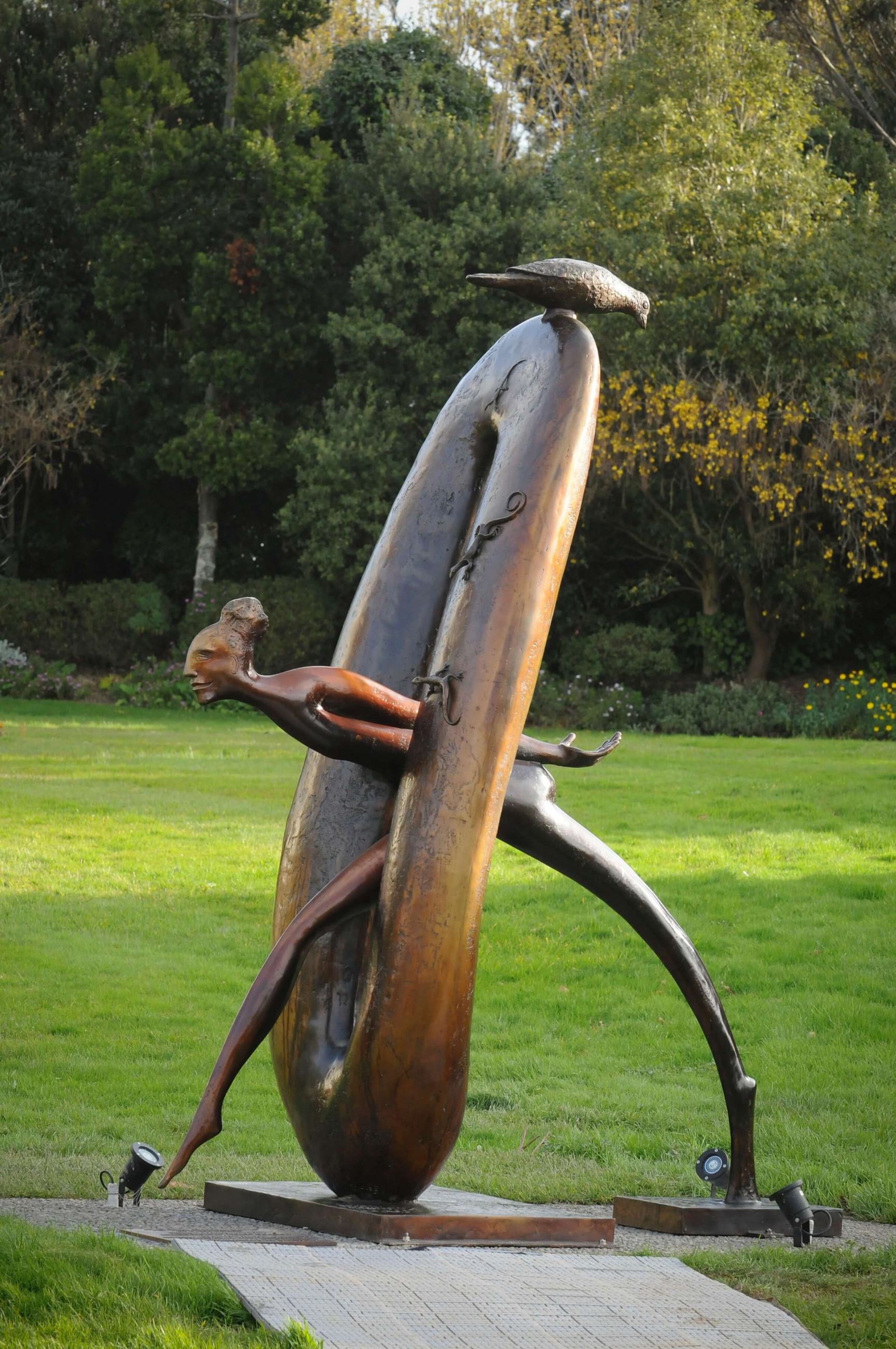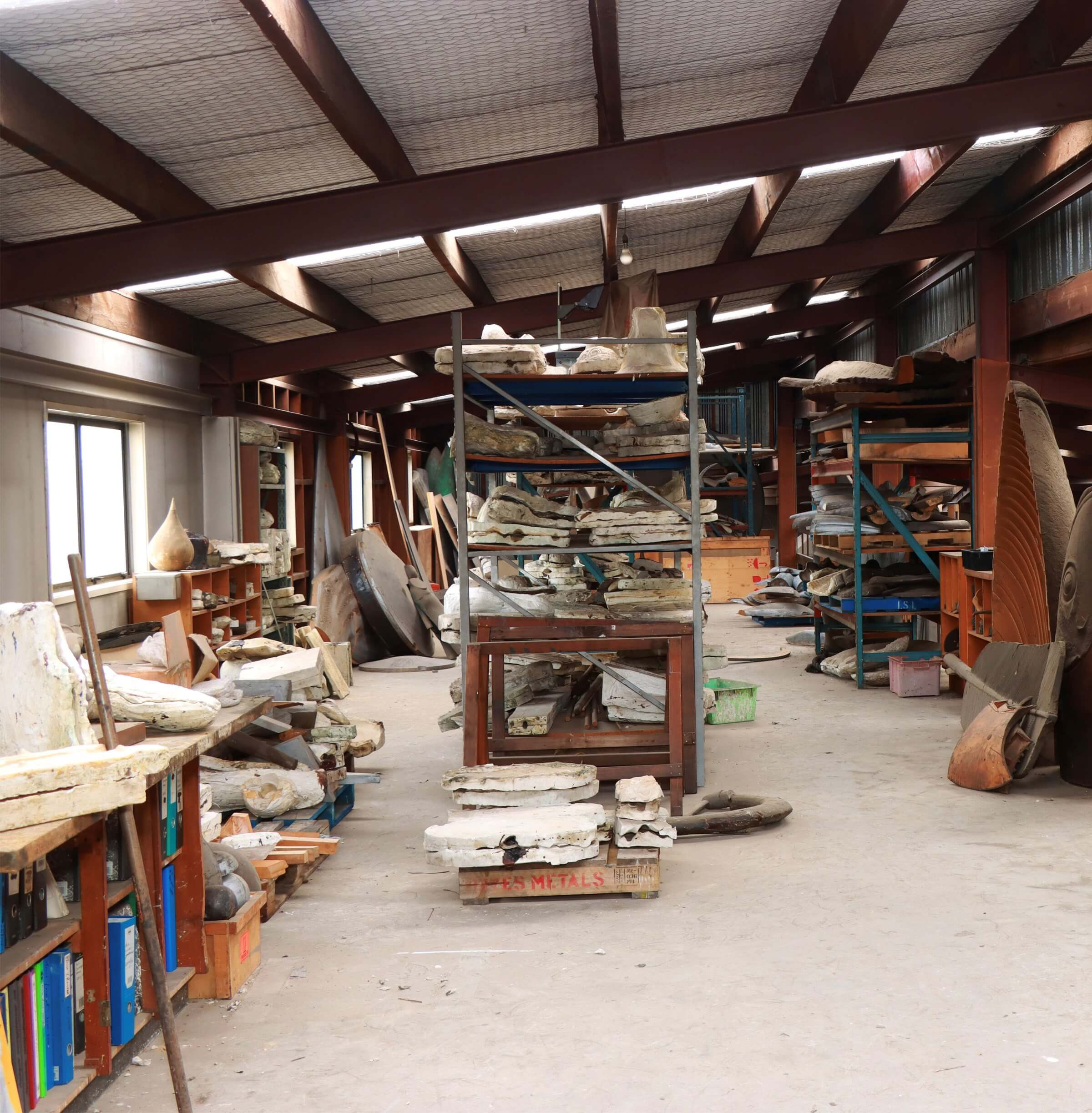Visit Sculptures In The Manawatū
Visit Sculptures In The ManawatūGhost of the Huia, 2010
Location: corner of Church Street and The Square, Palmerston North
Ghost of the Huia was installed in Palmerston North by the artist and Bronwyn Zimmerman, the artist’s gallery representative in the city, during a revitalisation project in which the City Council encouraged members of the community to take up “placemaking” to enhance public spaces in creative ways.
The huia is a particularly beautiful tribute for its significance to the Manawatū. The last confirmed sighting of a live huia was in the nearby Tararua ranges in 1907, before the bird was hunted to extinction by introduced predators and humans.
Huia were unusual in that they mated for life, so were particularly vulnerable. Male and female huia had dramatically different sized bills; hers was a long and slender curved bill, while his was shorter and less curved.
The huia ‘ghost’ in this work, with her large curved bill, is a female; she perches on a circular base of Corten steel.
The work is located at the intersection of Church Street and The Square, across from Square Edge Arts Centre, in Palmerston North.
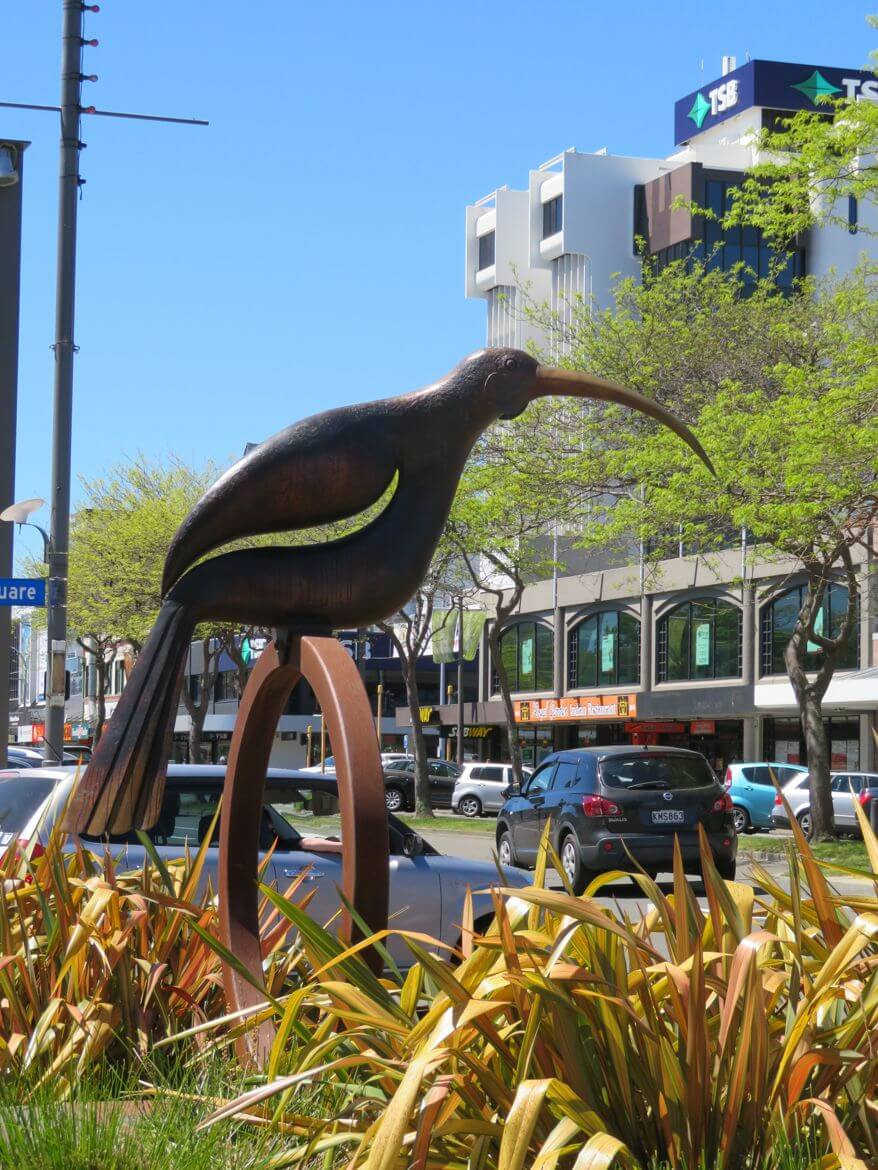
Waiting for Godot, 2013
Location: outside Zimmerman House, 310 Church Street, Palmerston North
Birds have long been a part of Dibble’s work. But there is a period when they became the central part of his sculptures, the primary focus within the artworks.
Dibble’s birds have distinct personalities, and we sense they coexist in their own discussions, in a world we’re not part of. In Waiting for Godot, named after the famous Beckett play, two birds sit on a Corten steel framework. The fabricated beams and circles suggest an urban environment, locating the birds on architecture rather than in native forest.
The higher is the kererū (woodpigeon) in regal repose, while a huia crouches lower down. We sense that they are aware of each other but without an obvious conversation or perhaps talking past each other.
Purchased by Bronwyn Zimmerman, the artist’s gallery representative in Palmerston North, the sculpture sits at Zimmerman House in Church Street, on view for anyone passing.
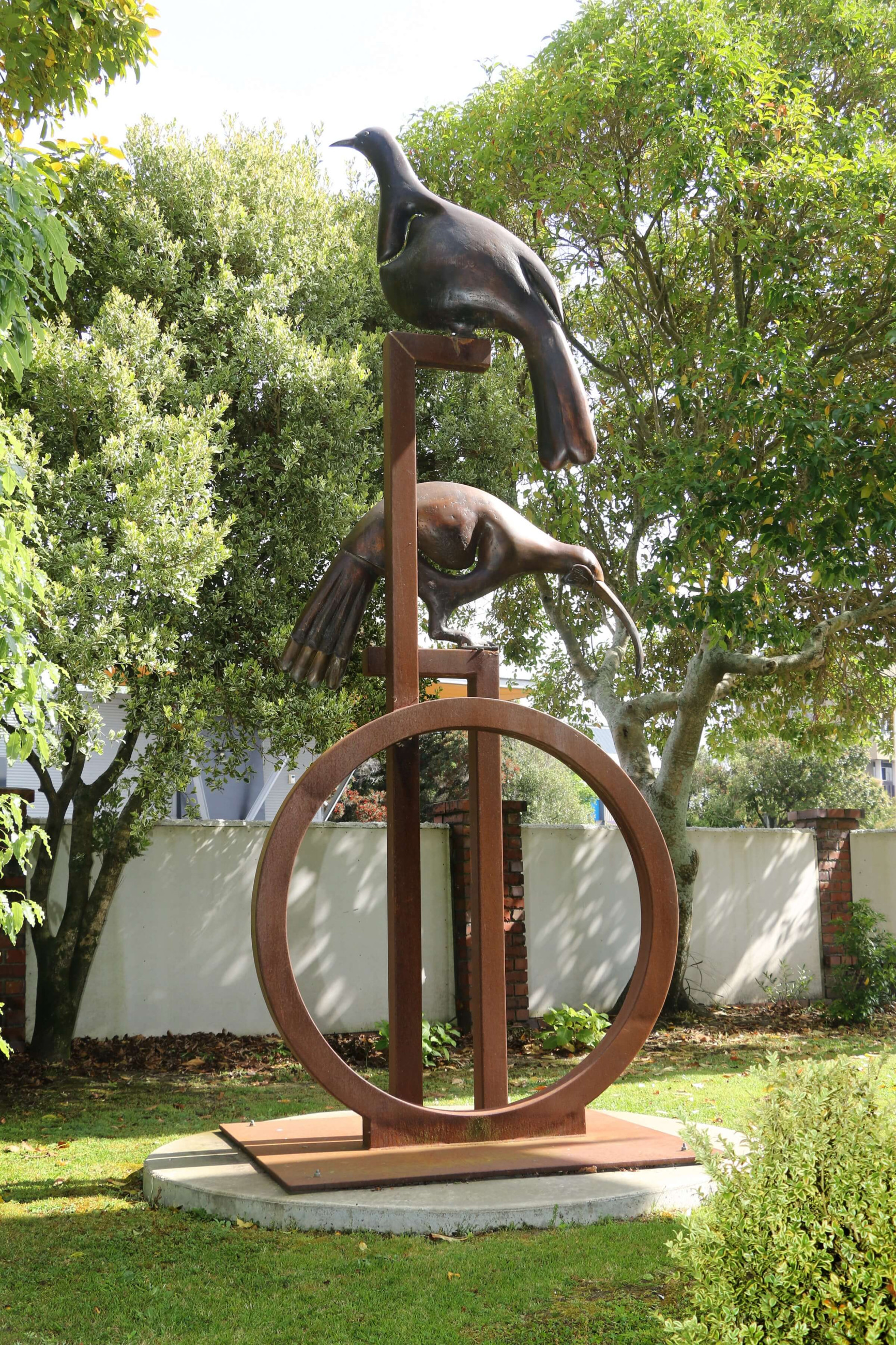
Pacific Monarch, 1992
Location: outside Te Manawa Art Gallery, 326 Main Street, Palmerston North
The funds to build a sculpture on this site came from a bequest from the estate of Gertrude Raikes, a local citizen known for her flamboyance, who died in 1985. The gallery, headed at that time by Director Julie Catchpole, worked with the Art Gallery Society to set up a competition to design a sculpture for the site, and in 1988 four sculptors were invited to submit proposals. Dibble’s entry, titled Papaioea (which translates as “there are beauties here”), referred to the area where surveyors first plotted the settlement of Palmerston North. It featured two walking figures, delicately making their way across the ground. The model Dibble submitted is retained in the gallery collection, but Dibble’s proposal was not accepted. It was not until 1991, when negotiations with the selected artist foundered, that the commission was given to Dibble.
Before accepting the commission Dibble put forward a new concept and model. After his new proposal was approved, work began on what was, at that time, the largest bronze work Dibble had attempted.
The sculpture is a semi-abstracted figure that looks to be balanced on two spindly props (this is a visual illusion, as the figure is in fact supported by an internal steel armature winding through the leg and body).
The figure’s headdress of leaves is intentionally ambiguous as to whether it is a ceremonial Pacific crown or more reminiscent of the Greenman of Celtic Europe. The figure is blindfolded, an indication of the state of the settlers who were immigrants to an unknown land, blind to their futures. On the underside of the legs are barnacles, while honeycomb and bees are present further up the torso; bees moving into abandoned structures, here as analogy for the stories and myths from an old land left behind, and barnacles as if on the underside of a ship suggesting the long voyage settlers made.
In one hand the figure holds a plumb bob, demonstrating an intent to settle. The other hand balances a globe, acknowledging that many settlers moved halfway round the world to their new home. Notably the United States of America has been omitted from the globe (a quiet protest by Dibble on the emphasis given to international art by curators at the time). A clear view of New Zealand is evident from the ground, where people look up at the work from below.
A video of the making of Pacific Monarch, titled “Intent to Construct”, aired on national television.

All Creatures Great, 1996
Location: mezzanine level entry to Palmerston North City Library, 4 The Square, Palmerston North
When the Palmerston North City Library moved across The Square to a new site, it sought to introduce a completely new philosophy. As well as people coming to the library to take out reading material, it aimed to welcome them in to “the living room of the city” by arranging the environment in a new way. This project was undertaken by Head Librarian Anthony Lewis working with the firm Athfield Architects, the project headed by architect John Hardwick-Smith. Part of the brief involved including local artists’ work in the new building.
Originally the site for the sculpture was an area overlooked by the children’s section of the library (although this was later shifted), but the sculpture was always intended to be sited at the main entrance.
The concept for All Creatures Great was translated literally from a small model made seven years earlier. The idea came from a children’s book that demonstrated the size of a whale as being equal to the height of ten elephants stacked on top of each other. The sculpture features these ten elephants alongside a whale, rising on its tail from an atrium pond. The animals form the support for a pediment, on which is an arm holding a plump bob. In its playful way it raises conservation issues, suggesting the power humans have on the mighty creatures of the world (the biggest land animal and the biggest sea animal), and instils notions of protection and the precarious balance of nature.
Dibble went on to work with architect John Hardwick-Smith again on Southern Stand: The New Zealand Memorial located at Hyde Park Corner in London.
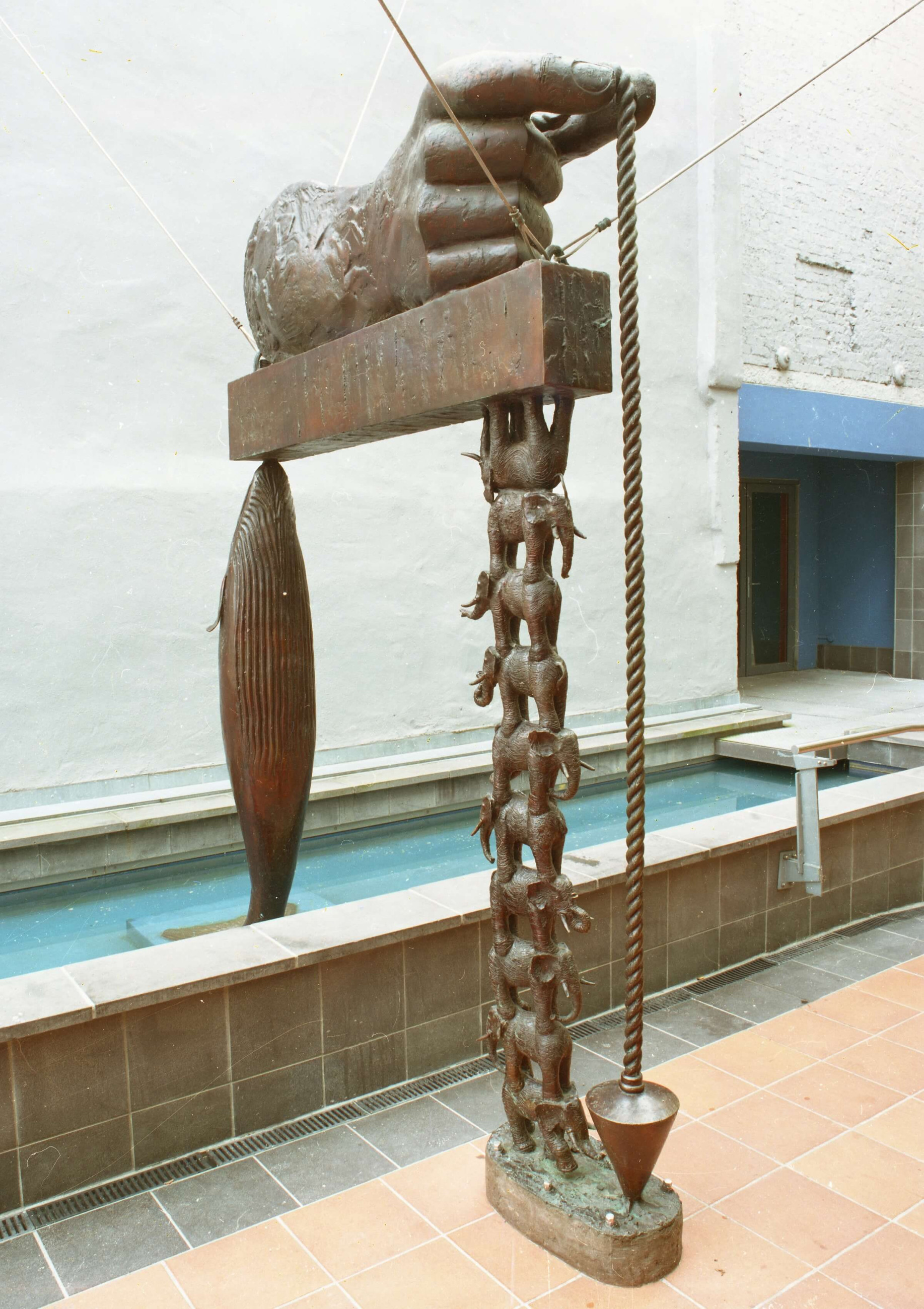
Who’s Afraid, 2011
Location: outside the Regent Theatre, 53 Broadway Avenue, Palmerston North
In Who’s Afraid a female dancer confronts a tuatara (a New Zealand reptile sometimes referred to as a “living dinosaur”). This is a sculpture with a high sense of the dramatic, the artwork contrasting the agility of youth with a pre-historic animal.
This work sits within a series that was first aired in an exhibition called “The Dance” in 2010. It was a playful menagerie of dancers, acrobats, birds and other animals. This reflection on the triumph of youth, of age and on time passing may have been precipitated by the death of a fellow student who had graduated with Dibble from art school.
Who’s Afraid, enacting an impossible dialogue between a tuatara and a dancer, is a standoff that is both dramatic and absurd. There is a nervous tension between the two and it is ambiguous as to who is the performer and who is the audience. This confrontation mirrors the life of an artist - whether a visual artist or performer.
The work was commissioned by the Palmerston North Public Sculpture Trust and is aptly suited for display outside the city’s performing arts theatre.
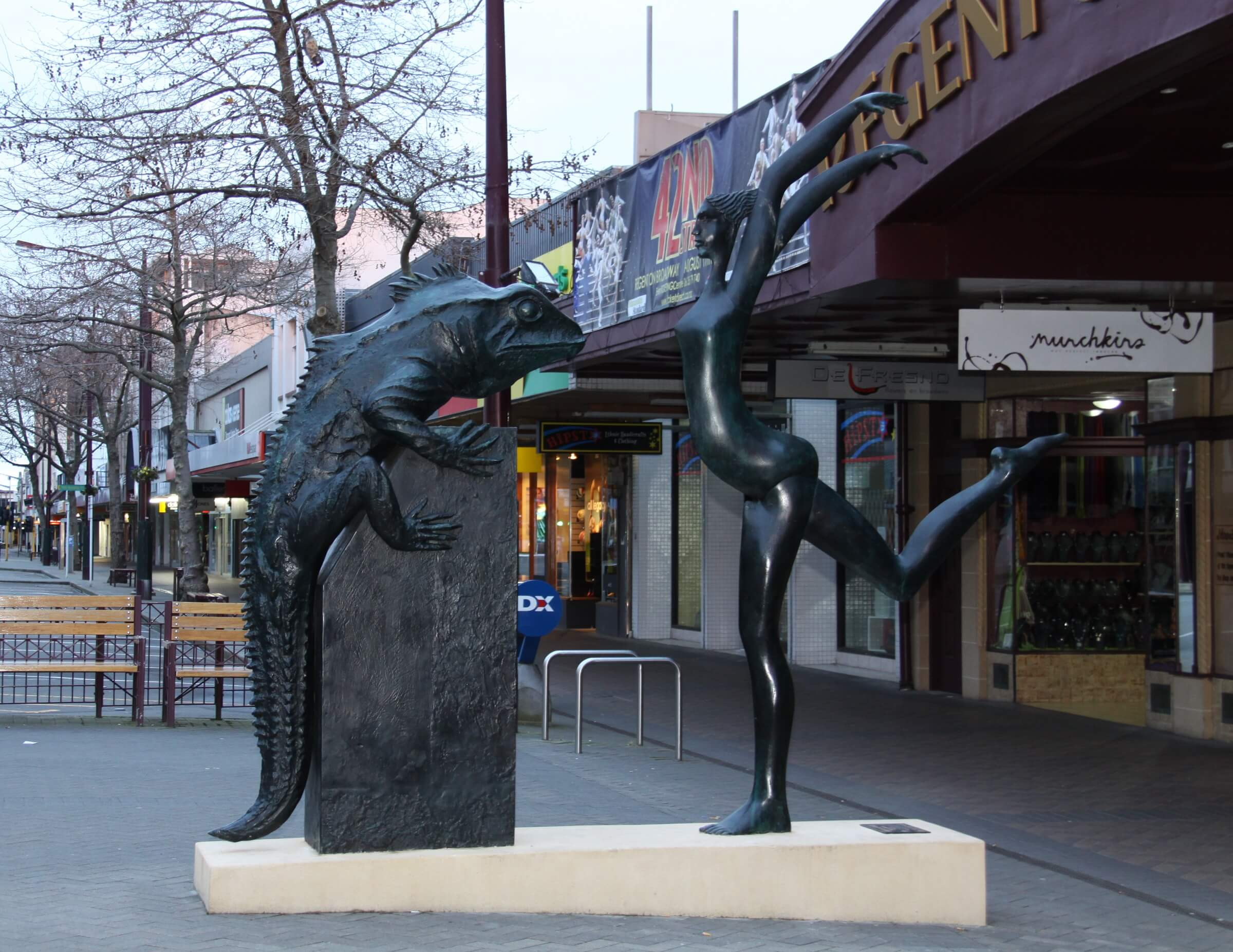
The Nectar Eaters, 2003
Location: outside UCOL Te Pūkenga, 18 Princess Street, Palmerston North
Nectar Eaters stands as a tribute to the Manawatū; an historical reference to the land and people of the region, interweaved with nature by the common thread of flax.
The swampland of the Manawatū plains, before it was drained for cultivation, provided fertile ground for flax plants. Leaves were harvested and pounded by Māori using stone pounders - beautifully rounded tools, patinated by the wear of hands. Flax served as an industry for both European settlers and Māori. It was used to make humble binder twine, a product that, in the 1870s and 80s, played a large part in the development of Palmerston North and the nearby towns of Shannon and Foxton.
In Nectar Eater’s a massive flax pounder is surrounded by a swirl of birds. Tūī, bellbirds and stitchbirds flutter about the pounder in furious, riotous motion, as if punch drunk on flax berries, their spiralling flightlines tracked on the pounder’s surface. Meanwhile two ancient huia, as still ghosts, perch at the high point of the handle.
The sculpture was purchased by UCOL in 2003.

Dawn Chorus on the Fish of Māui / Te Pūatatangi ki Te Ika a Māui, 2019
Location: Central Energy Trust Wildbase Recovery, Victoria Esplanade, 1 Palm Drive, West End, Palmerston North
Dawn Chorus on the Fish of Māui involved more than a decade of making, evolving and journeying, seeming at times to have a spirit of its own. A fish holds up a platform, or small piece of land, on its nose - as if rising out of the ocean to create an island. This brings to life the legend of the demigod Māui fishing up the North Island. The platform also refers to the hākari platforms, used historically by Māori, where food was piled high on multiple layers for significant occasions and gatherings, with ideas of celebration and a land of plenty.
The giant fish in this work originally rose under a cityscape of Auckland. Dibble then discarded the cityscape, and instead a volcano and two large birds were installed on the platform. But Dibble found fault with this variation and swapped it for this version with a tree. As the fish holds up this tree, so the tree becomes a holder for a tree-full of birds, local native birds even including the ghost of an ancient huia. The huia is a special tribute to this region from where it was last seen before extinction.
Over the last three years of its genesis various additional birds were added to the menagerie. The ruru (native owl) was an important addition for two reasons. “Nightshade” the ruru was one of the poster shots for the nearby Wildbase Recovery centre, the rescue bird pictured on social media with a small towel wrapped around it, a touching poignant portrayal. But the owl is also considered something of a personal symbol for Dibble’s hometown, Waitakaruru, which translates as “where the owl sits on the water”. The final rollcall of birds in the tree became a list of nine: pīwakawaka (fantail), tūī, huia, kererū (woodpigeon), kōkako, saddleback, korimako (bellbird), kingfisher and of course “Nightshade” the ruru.
This work was purchased by the Palmerston North Public Sculpture Trust supported by Wildbase Recovery Community Trust.
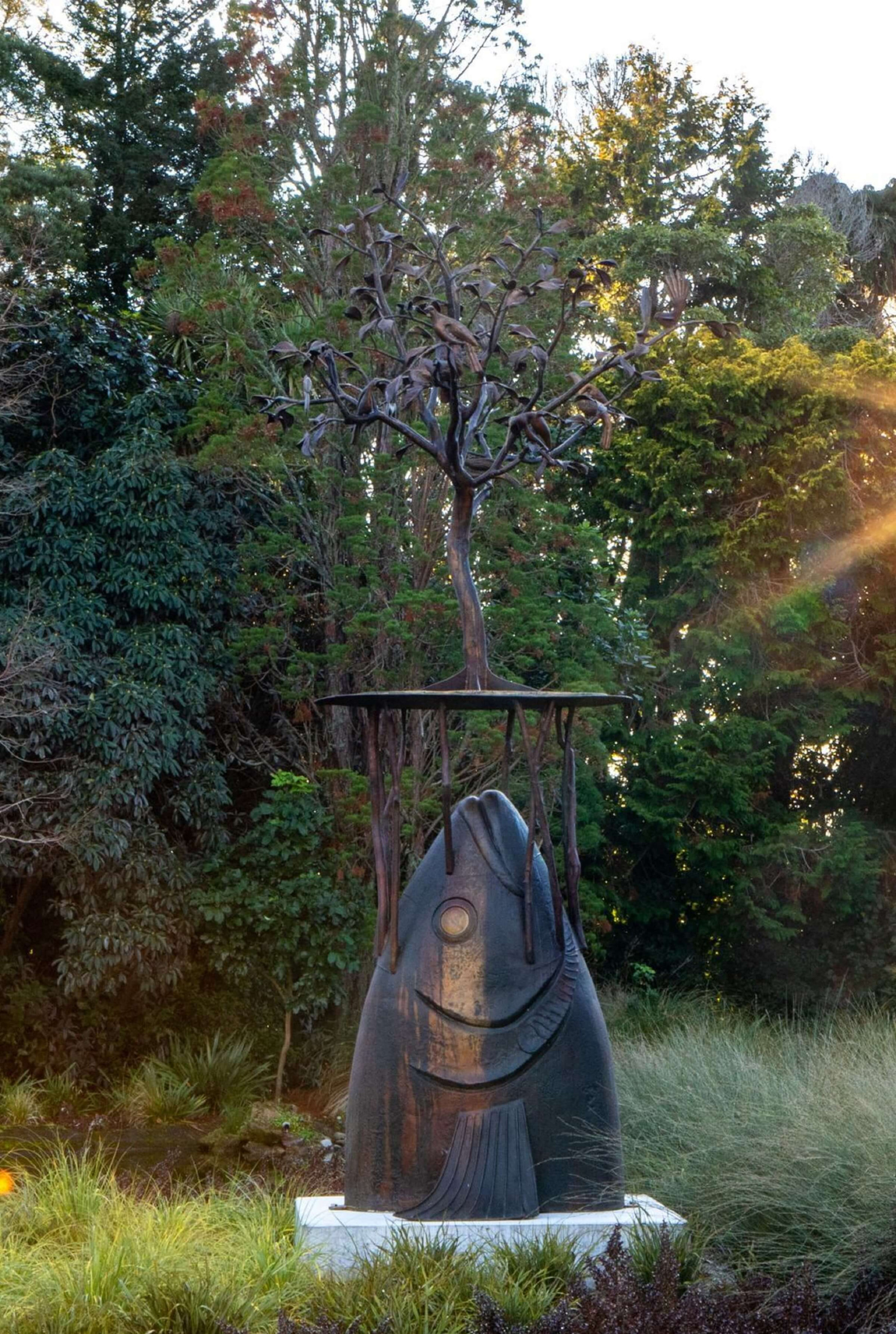
Impossible Dialogue, 1988
Location: outside the Registry Building, Massey University, Tiritea Road, Palmerston North
Dibble created a small number of sculptures using sheet steel, bent by using giant industrial presses and bolted together in a method similar in principle to origami, yet producing works sturdy enough to withstand outdoor conditions. This was pivotal for Dibble, in his move to work out technical methods to produce large works that could become landmarks and be a part of cities instead of contained within gallery walls.
Impossible Dialogue is the last of Dibble’s “foldings”. It features a large bold figure balanced on three legs. An energetic piece, fitting for a university campus, its arms are raised in enthusiastic gesture and it has a manic smile. One of Dibble’s signature parrots, the figure’s conversation partner, swings on a small rod that reaches out from the body.
The work was originally shown at The Dowse Art Museum in Lower Hutt. After the exhibition was completed, Dibble applied for the work to be purchased by the Palmerston North College of Education (where he was teaching) for the cost of its production. After the College of Education merged with Massey the work ended up in storage.
With the assistance of local gallerist Bronwyn Zimmerman, Impossible Dialogue was retrieved from storage, refurbished and installed in 2016 at its current site on the Massey University campus in Palmerston North.
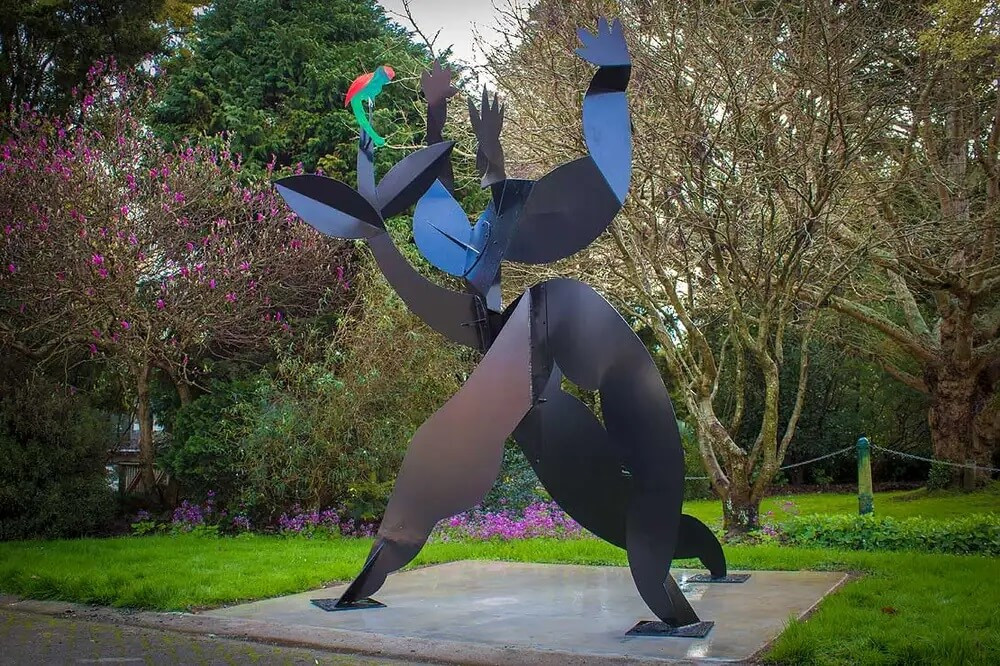
To the Other Side, 2007
Location: IPU New Zealand, 57 Aokautere Drive, Fitzherbert, Palmerston North
Creation stories and accounts of immortality are widespread among cultures throughout the world. Within New Zealand, Māui reigns as the demigod of favour, his antics and mischievous character a feature of many of this hero’s exploits. While God-like in his abilities, he is emphatically human in his emotions.
The figure in To the Other Side is an abstracted depiction of Māui, documenting his exploits to cheat death and obtain immortality.
The sculpture portrays the journey into an afterlife, a brave leaping, but also the stepping out into any unknown, overcoming fear and foreboding to find a better life beyond. It is thus a monument to courage.
Adorning the surface of the gateway are lizards, guardians in their mythical histories, giving luck to the voyageur on his journeys. At the very top is perched a strange bird, based in form on Korotangi (bird of sorrow), a sacred artifact carved in stone that is one of the most famous of tribal heirlooms. It is believed to have been carried on the ancestral Tainui waka (canoe) when it arrived in New Zealand. Korotangi is thought to be about four thousand years old of Asiatic - some believe specifically Japanese - origin. The bird’s appearance on the sculpture gives an undefined sense of time, of a history past and life stretching to the immortal.
Purchased by IPU New Zealand to mark their 20th anniversary, To the Other Side is positioned near the Administration Centre.
